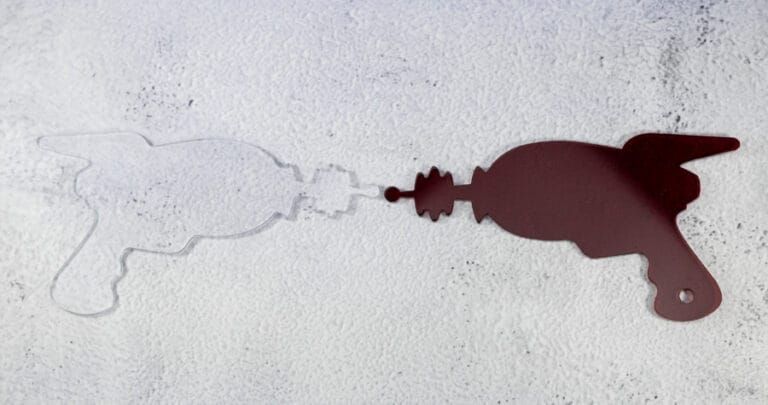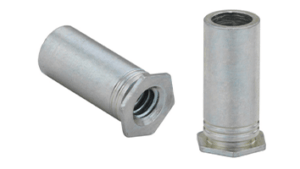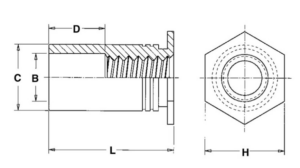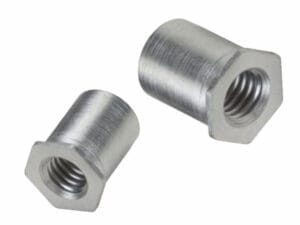Plastic is a modern wonder material. Plastics have been developed with all sorts of unique properties for a variety of applications. Today we’re going to dig into two very similar, but still unique plastics. You’ve already seen the title, you know we’re talking acrylic and polycarbonate.
Both of these amazing polymers are available from SendCutSend, cut to nearly any shape you can design. To help you make the best design decisions, we’ll explain the differences between them and applications where each would be a better choice than the other.
Read on.
Polycarbonate vs. Acrylic: Differences and Properties
Let’s get the technical stuff out of the way. Both polycarbonate and acrylic are thermoplastic polymers. Polymer meaning they are made up of chemical chains of molecules. Thermoplastic meaning they can be heated until soft, then formed into a new shape and will reharden once cool. This differentiates them from thermosetting plastics, which can’t be reshaped after its initial forming. They’re both manufactured in a variety of shapes, including flat sheets of different thicknesses.
Both have trade names that are very popular, Lexan for polycarbonate and Plexiglass (or Plexiglas) for acrylic. There are many more proprietary names for each, but those are the most common you’re likely to hear.
Unlike other SendCutSend plastics (ABS, Delrin and Polyethylene), acrylic and polycarbonate are naturally clear, but can be tinted different colors. They’re often great alternatives to glass, especially because they’re significantly lighter, stronger and less likely to break than glass. Both are stronger than glass when it comes to resisting impacts, but they’re more likely to scratch than glass.
Either material can be extruded into various shapes. Polycarbonate is also often injection molded to make containers like bottles and other shapes. Acrylic can be extruded or cast, but extruding can leave the material with direction specific properties, where it’s stronger in one direction and weaker than another. Casting acrylic produces much more uniform properties. SendCutSend uses cast acrylic.
Under the right conditions, they each have good chemical resistance. Weak acids, detergents and most solvents are fine. Acetone won’t necessarily dissolve either, but it can cause softening and damage. Isopropyl alcohol is a better alternative for polycarbonate, but don’t use it on acrylic.
Differences
For most applications they can be used interchangeably. Their differences are relatively subtle, but they are different. We’ve compiled a list of differences between acrylic and polycarbonate.
- Acrylic is slightly harder, making it more resistant to scratching.
- Polycarbonate is more flame resistant than acrylic, although acrylic is often flame polished to smooth out rough cut edges.
- Acrylic can be polished to remove scratches, using either abrasives or heat. (bonus: laser cut acrylic edges are already smooth and shiny)
- Polycarbonate is tougher and can resist impacts much better.
- Acrylic takes the win for optical clarity, beating even glass.
- Polycarbonate can handle plastic deformation, meaning it can be bent into permanent shapes similar to sheet metal. In fact, bending polycarbonate is a service SendCutSend now offers. Acrylic on the other hand is more brittle, but still much more flexible than glass. Acrylic can be bent, but requires being heated to prevent cracking.
- Acrylic generally costs less than polycarbonate.
- Polycarbonate can withstand extreme cold temperatures better than acrylic without becoming brittle.
- Acrylic has better UV resistance, where polycarbonate will start to yellow after being exposed for a long time.
- Bonding acrylic is a little simpler than polycarbonate and can leave an invisible bonded joint.
If specs are your thing, we’ve got those too. You can see from some of these values just how similar these materials are, and how they differ.
| Acrylic Properties | Polycarbonate Properties | |||
| Density | 74 lb/ft^3 | Density | 75 lb/ft^3 | |
| Tensile Strength (Ultimate) | 10 ksi | Tensile Strength (Ultimate) | 9.5 ksi | |
| Shear Modulus | 250 ksi | Shear Modulus | 120 ksi | |
| Flexural Strength | 16 ksi | Flexural Strength | 13 ksi | |
| Rockwell Hardness | M93 | Rockwell Hardness | 68 | |
| Elongation at Break | 0.04 | Elongation at Break | 1.1 | |
| Elastic Modulus | 460 ksi | Elastic Modulus | 340 ksi | |
| Comprehensive (Crushing) Strength | 16 ksi | Comprehensive (Crushing) Strength | 12 ksi | |
| Thermal Conductivity | 0.11 BTU/h-ft-°F | Thermal Conductivity | 0.11 BTU/h-ft-°F | |
| Melting Point | 360 °F | Maximum Temp (Decomposition) | 890 °F | |
| Magnetic | No | Magnetic | No | |
| Acrylic Services | Polycarbonate Service | |||
| Cutting Process | CO2 Laser | Cutting Process | CNC Router | |
| Bending | No | Bending | Yes | |
| Tapping | No | Tapping | Yes | |
You can check out even more information for acrylic and polycarbonate on their respective material pages.
Acrylic and Polycarbonate Plastic Uses
As we mentioned, acrylic and polycarbonate are very similar with subtle differences. Both are regularly used as lightweight replacements for glass or in applications where impacts could break regular glass. Let’s explore some common applications for each.
Common Polycarbonate Applications
Because polycarbonate is known for incredible impact resistance it tends to be used more in applications where safety or performance are needed.
- Bulletproof and bullet resistant windows
- Lenses
- 3d printer filament
- Safety equipment like shields, goggles and guards
- Motorsports windshields
- Aircraft windows
- CDs, DVDs, Blu-Ray discs
- Electronics
- Roofing panels
- Greenhouse panels
Common Acrylic Applications
The lower cost and better clarity of acrylic make it the more common choice for less critical applications and decorative applications.
- Lenses
- Signage
- Custom lighting
- Aquariums
- Ornaments
- Table and desk tops
There’s no limit to what can be made with either of these amazing materials. If you’re looking for some inspiration, check out what our customers have made using acrylic and polycarbonate.
Polycarbonate vs. Acrylic: How Much Do They Cost?
Often cost is a big driver when choosing a material for your project. Both of these can be good alternatives to glass. While cost can vary based on many factors, polycarbonate is typically similar in cost to regular glass. Acrylic is usually the lower cost option. Thickness, color, finish and other properties can influence the cost, but in general you’ll find acrylic cheaper than polycarbonate.
You can always get a free instant quote for your specific designs, but here’s an example part to show the relative costs of these materials from SendCutSend. For similar thickness clear sheets, acrylic is close to half the cost of polycarbonate. Switching to a mirrored acrylic and the cost is much closer.
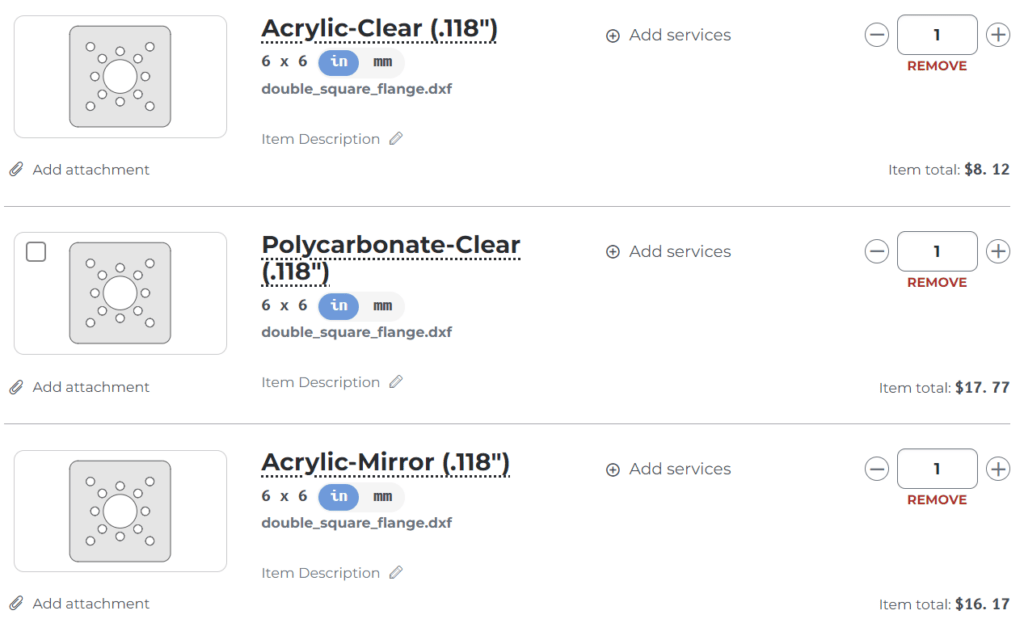
Polycarbonate vs. Acrylic: Recyclability & Sustainability
Plastics are modern miracle materials, with their long list of benefits and capabilities. But if plastics have a drawback it’s their environmental impact. Plastics have come a long way and many can be fully recycled. Both acrylic and polycarbonate fall into plastic recycling group 7. This means they can be recycled, but not as readily as other plastic types. While they are technically fully recyclable and can be reprocessed into new products, not all recycling facilities process group 7 plastics. On the other hand, you can actually find both polycarbonate and acrylic in 100% recycled form.
It should also be noted that because they are thermoplastics rather than thermosets, at the end of their product lives they can be heated and reshaped to be repurposed into new products.
How to Choose Between the Two
Polycarbonate and acrylic can be a great choice for any project. Beautiful and strong, they don’t rust like steel, but can be formed into different shapes. They’re electrically insulating, and can take a beating. They are great options for replacing glass because they’re clear, can survive impacts much better and weigh significantly less.
These materials are easy to work with, but if you don’t have the time or tools there’s always SendCutSend. We carry both acrylic sheets and polycarbonate sheets in different thicknesses. You can get ultra tough polycarbonate cut and bent at SendCutSend, ready to go when it arrives at your door. Or if laser cut acrylic is your choice, we have a variety of colors and the laser cutting leaves a smooth shiny edge.
If you need other materials for your project, we’ve got that covered too. Check out the list of materials and services you can get from SendCutSend. If you need help choosing the best material, we’re here to help. We’ve put together a material selection guide and if you still have questions our application engineers are ready to help. Get your free instant quote today.
